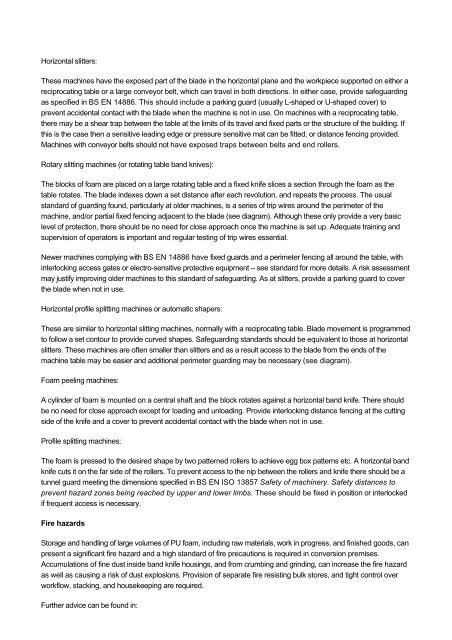Introduction to rubber processing and safety issues - HSE
Introduction to rubber processing and safety issues - HSE
Introduction to rubber processing and safety issues - HSE
You also want an ePaper? Increase the reach of your titles
YUMPU automatically turns print PDFs into web optimized ePapers that Google loves.
Horizontal slitters:<br />
These machines have the exposed part of the blade in the horizontal plane <strong>and</strong> the workpiece supported on either a<br />
reciprocating table or a large conveyor belt, which can travel in both directions. In either case, provide safeguarding<br />
as specified in BS EN 14886. This should include a parking guard (usually L-shaped or U-shaped cover) <strong>to</strong><br />
prevent accidental contact with the blade when the machine is not in use. On machines with a reciprocating table,<br />
there may be a shear trap between the table at the limits of its travel <strong>and</strong> fixed parts or the structure of the building. If<br />
this is the case then a sensitive leading edge or pressure sensitive mat can be fitted, or distance fencing provided.<br />
Machines with conveyor belts should not have exposed traps between belts <strong>and</strong> end rollers.<br />
Rotary slitting machines (or rotating table b<strong>and</strong> knives):<br />
The blocks of foam are placed on a large rotating table <strong>and</strong> a fixed knife slices a section through the foam as the<br />
table rotates. The blade indexes down a set distance after each revolution, <strong>and</strong> repeats the process. The usual<br />
st<strong>and</strong>ard of guarding found, particularly at older machines, is a series of trip wires around the perimeter of the<br />
machine, <strong>and</strong>/or partial fixed fencing adjacent <strong>to</strong> the blade (see diagram). Although these only provide a very basic<br />
level of protection, there should be no need for close approach once the machine is set up. Adequate training <strong>and</strong><br />
supervision of opera<strong>to</strong>rs is important <strong>and</strong> regular testing of trip wires essential.<br />
Newer machines complying with BS EN 14886 have fixed guards <strong>and</strong> a perimeter fencing all around the table, with<br />
interlocking access gates or electro-sensitive protective equipment – see st<strong>and</strong>ard for more details. A risk assessment<br />
may justify improving older machines <strong>to</strong> this st<strong>and</strong>ard of safeguarding. As at slitters, provide a parking guard <strong>to</strong> cover<br />
the blade when not in use.<br />
Horizontal profile splitting machines or au<strong>to</strong>matic shapers:<br />
These are similar <strong>to</strong> horizontal slitting machines, normally with a reciprocating table. Blade movement is programmed<br />
<strong>to</strong> follow a set con<strong>to</strong>ur <strong>to</strong> provide curved shapes. Safeguarding st<strong>and</strong>ards should be equivalent <strong>to</strong> those at horizontal<br />
slitters. These machines are often smaller than slitters <strong>and</strong> as a result access <strong>to</strong> the blade from the ends of the<br />
machine table may be easier <strong>and</strong> additional perimeter guarding may be necessary (see diagram).<br />
Foam peeling machines:<br />
A cylinder of foam is mounted on a central shaft <strong>and</strong> the block rotates against a horizontal b<strong>and</strong> knife. There should<br />
be no need for close approach except for loading <strong>and</strong> unloading. Provide interlocking distance fencing at the cutting<br />
side of the knife <strong>and</strong> a cover <strong>to</strong> prevent accidental contact with the blade when not in use.<br />
Profile splitting machines:<br />
The foam is pressed <strong>to</strong> the desired shape by two patterned rollers <strong>to</strong> achieve egg box patterns etc. A horizontal b<strong>and</strong><br />
knife cuts it on the far side of the rollers. To prevent access <strong>to</strong> the nip between the rollers <strong>and</strong> knife there should be a<br />
tunnel guard meeting the dimensions specified in BS EN ISO 13857 Safety of machinery. Safety distances <strong>to</strong><br />
prevent hazard zones being reached by upper <strong>and</strong> lower limbs. These should be fixed in position or interlocked<br />
if frequent access is necessary.<br />
Fire hazards<br />
S<strong>to</strong>rage <strong>and</strong> h<strong>and</strong>ling of large volumes of PU foam, including raw materials, work in progress, <strong>and</strong> finished goods, can<br />
present a significant fire hazard <strong>and</strong> a high st<strong>and</strong>ard of fire precautions is required in conversion premises.<br />
Accumulations of fine dust inside b<strong>and</strong> knife housings, <strong>and</strong> from crumbing <strong>and</strong> grinding, can increase the fire hazard<br />
as well as causing a risk of dust explosions. Provision of separate fire resisting bulk s<strong>to</strong>res, <strong>and</strong> tight control over<br />
workflow, stacking, <strong>and</strong> housekeeping are required.<br />
Further advice can be found in:
















